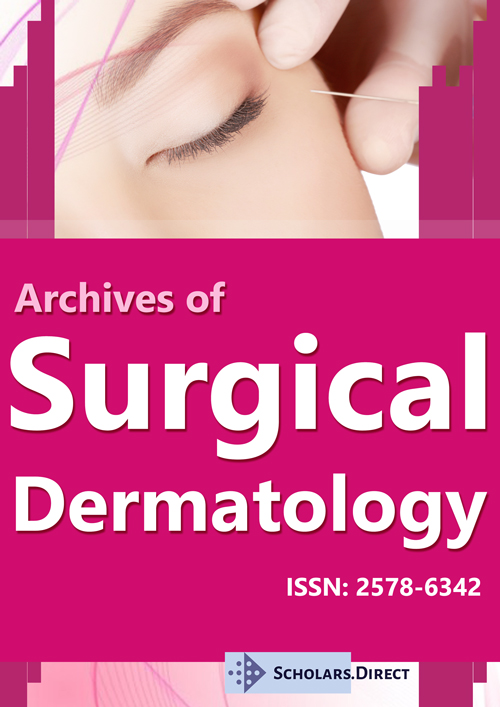Nasal Reconstruction under Local Anesthesia Following Skin Cancer Removal: A Retrospective Review of 575 Cases
Abstract
Background: Nasal reconstruction following skin cancer removal is challenging. Performing reconstruction under local anesthesia offers significant advantages.
Objective: This study examined repair strategies for nasal skin cancers treated by three academic Mohs micrographic surgeons.
Methods and materials: A retrospective review of records was performed for patients with nasal skin cancers (1/12018-2/1/2023). Patient, cancer, and repair characteristics were analyzed using descriptive statistics. The likelihood of repair strategies and surgical outcomes was determined using logistic regression.
Results: This study included 575 patients. Defects on the proximal nose were commonly repaired using complex linear closures and advancement flaps. Defects on the ala and tip had varied repair strategies, including staged interpolation and transposition flaps, skin grafts, and cartilage grafts. The rate of complications and contour deformities was 3.83% (n = 22/575) and 6.26% (n = 36/575), respectively.
Conclusion: Subunits with few variations in contour can be repaired using linear closures and advancement flaps; however, subunits with variations in contour require more complex repairs.
Introduction
The incidence of skin cancers in the United States is rising. In 2019, 2.8 million cases of basal cell carcinoma (BCC) and 1.5 million cases of squamous cell carcinoma (SCC) were diagnosed [1]. Nearly 30% of these malignancies occur on the nose [2-4]. Nasal reconstruction is challenging for surgeons, including Mohs micrographic surgeons, otolaryngologists, and plastic surgeons. The principles of nasal reconstruction have evolved to include greater granularity and an emphasis on aesthetics [5]. It is not sufficient to just “fill the hole,” but rather, to recreate the natural contours of the nose.
Achieving consistently optimal functional and aesthetic results while performing reconstruction under local anesthesia offers advantages with respect to patient safety, convenience, and cost. Adverse events from local anesthesia are exceedingly rare [6]. In one survey of the practices of over 400 Mohs surgeons, no cases of lidocaine toxicity were reported in the ten days studied [7]. In contrast, procedures performed under general anesthesia have longer operating times, higher hospital admission rates, and 243% greater procedure-related costs [8].
Despite advances in surgical techniques, there remains a lack of standardization and empirical evidence to guide surgeons in the repair of nasal defects. We examined nasal skin cancers treated by three Mohs micrographic surgeons over five years at our academic medical center. Our objective is to analyze patient and defect characteristics to guide the reconstruction of nasal defects after tumor excision under local anesthesia.
Patients and Methods
A retrospective medical record review was conducted of patients who presented to the Dermatologic Surgery clinic with nasal tumors between 1/1/2018 and 2/1/2023. Dermatologic surgeons performed Mohs micrographic surgery (MMS) as indicated by the Mohs appropriate use criteria or staged excisions [4]. All defects were reconstructed using standard principles of aesthetic nasal reconstruction. Only patients with complete medical records were included.
Patient data collected included demographics and comorbidities (history of smoking, nasal surgery, anticoagulation, immunosuppression, other medical conditions). Data collected regarding skin cancers included recurrence, histologic findings (differentiation, perineural invasion), site as defined by subunit, AJCC and BWH staging, Mohs AUC score, Mohs stages required for clearance, and depth of tissue involved. Repair data collected included defect size, repair type, and surgical outcomes.
Patient and skin cancer characteristics were analyzed using descriptive statistics. Univariate logistic regression was used to determine the likelihood of surgical repair strategies, and both univariate and multivariate logistic regression were used to determine the likelihood of complications and contour deformities. Data were analyzed using GraphPad Prism 9.5.1.
This study was approved by the Institutional Review Board of the Ronald O. Perelman Department of Dermatology, New York University Langone Health, New York, NY.
Results
Table 1 details patient and skin cancer characteristics. There were 575 patients included. The average age was 71.03 years, and most patients identified as white (n = 498, 86.26%). The ala (n = 184, 32.00%), sidewall (n = 147, 25.57%), and tip (n = 118, 20.52%) were the most common subunits involved.
Repair strategies by subunit
For defects involving the root (n = 14), the most common repair was complex linear closure (n = 6/14, 42.86%), which was used in nearly all defects with diameter < 1.5 cm. In defects > 1.5 cm, the most common repair was the rotation flap, particularly glabellar rotation flaps.
On the dorsum (n = 105), the mean defect size was 1.49 cm 2 (standard deviation (SD) 1.77). Complex linear closures were the most common repairs (n = 41/105, 39.05%), but their use was largely limited to defects < 1.5 cm. Advancement flaps were the second most common repairs (n = 31/105, 29.52%), particularly single tangent (Burow’s) and A-T flaps.
On the sidewall (n = 147), nearly half of defects involved another nasal or facial subunit (n = 69/147, 46.94%). The average defect size was 1.80 cm 2 (SD 2.80). The most common repair strategy was advancement (n = 52/147, 35.37%), particularly crescentic advancement flaps (n = 31/52, 59.62%) and single tangent advancement flaps (n = 12/52, 23.08%). Complex linear closures were the second most common repair and were utilized for smaller defects (n = 42/147, 28.57%).
The average defect size on the ala (n = 184) was 1.42 cm 2 (SD 1.63). The most common repair was the staged interpolation flap (n = 64/184, 34.78%), particularly the staged melolabial flap (n = 46/64, 71.88%). Staged interpolation flaps were frequently used in cases involving multiple subunits. Over half (n = 37/64, 57.81%) were performed in conjunction with a cartilage graft. The second most common repairs for the ala were transposition flaps (n = 39/184, 21.20%), of which the bilobed flap was the most common (n = 27/39, 69.23%). The use of transposition flaps was primarily limited to defects < 1.5 cm in diameter. Full-thickness skin grafts were also frequently utilized on the ala (n = 33/184, 17.93%), mostly for defects < 1.5 cm.
Repairs of the nasal tip (n = 118) were varied. The average defect size was 1.61 cm 2 (SD 1.95). The tip was most frequently repaired using transposition flaps (n = 33/118, 27.97%), particularly the bilobed flap. Complex linear closures (n = 30/118, 25.42%) were the second most common strategy. This was followed by rotation flaps (n = 22/118, 18.64%), particularly the dorsal nasal flap. The largest defects (diameter > 2 cm) were most often repaired using the paramedian forehead flap.
The columella (n = 3) was repaired using full-thickness skin grafts (n = 2) or the bilobed flap (n = 1). The soft triangle (n = 4) was repaired using the staged melolabial flap with cartilage graft (n = 2), the bilobed flap (n = 1), or full-thickness skin grafting (n = 1).
Table 2 details the odds of using repair strategies for specific subunits. The odds of utilizing complex linear closures were significantly higher on the root, dorsum, tip, and sidewall compared to the ala. Advancement flaps were more likely on the dorsum and sidewall than the ala. Transposition flaps were less likely on the dorsum, and rotation flaps were more likely on the root and tip. Staged interpolation flaps and full-thickness grafts were significantly more likely on the ala than nearly all other sites.
Surgical outcomes
The rate of complications (e.g., infection, hematoma, dehiscence, necrosis) was 3.83% (n = 22/575). The rate of contour deformities was 6.26% (n = 36/575). Contour deformities were primarily managed with intralesional steroids. Infections were managed with oral antibiotics. Only 11/575 cases (1.91%) required surgical revision. On univariate analysis, immunosuppression, multiple subunit involvement, size > 2 cm 2 , staged interpolation flap, and cartilage graft had an increased likelihood of complications Table 3. On multivariate analysis, none of these remained significant, although immunosuppression trended towards significance (OR 3.05, 95% CI 0.89-9.10, p = 0.0556). Of the immunosuppressed patients who experienced complications (n = 5), two were solid organ transplant recipients, and three were receiving other immunosuppressive medications. Infection (n = 2) and graft/flap failure (n = 2) were the most common complications. On univariate analysis, involvement of the tip, dorsum, and sidewall had lower odds of contour deformities, while multiple subunits, size > 2 cm 2 , transposition flap, staged interpolation flap, and cartilage grafting had higher odds. However, on multivariate analysis, none of these remained significant.
Discussion
The data we present details strategies used successfully to repair nasal defects under local anesthesia. Given the functional and aesthetic importance of the nose, the appropriate repair must be selected carefully.
Secondary intent
Secondary intent (SI) may be appropriate for small, partial-thickness defects on the distal third of the nose, particularly convex surfaces. In one study, the best scar outcomes for SI were on the ala, while the worst outcomes were on the tip [9]. We typically consider SI for patients with numerous comorbidities, highly sebaceous skin, or patients who do not desire reconstruction; however, they must be able to perform weeks of wound care and follow-up. Due to the unpredictable cosmetic and functional results of SI for deep defects, we favor repair in most cases.
Full-thickness skin grafting
FTSG is particularly useful for small superficial defects or in areas of limited laxity such as the ala, as flaps can cause distortion in these locations. Some studies have demonstrated poorer cosmetic outcomes with FTSG compared to flaps [10,11]. However, in our experience, these can improve substantially with minor post-operative interventions (i.e. steroid injections, laser, or dermabrasion). When employing FTSG, we select a donor site that closely matches the recipient tissue, trim the fat to promote viability, and bolster the graft to facilitate revascularization.
Linear closure
Prior studies have noted that linear closures are useful for small defects on the sidewall, root, or dorsum, likely due to the limited variation in contours and textures at these sites [12,13]. We also utilized linear closures for the tip. We consider use of interdomal sutures for linear closures involving the nasal tip [14]. Given that linear closures require less manipulation of the tissue, they allow for efficient, aesthetic repairs with low risk of complications.
Advancement flaps
Advancement flaps were common on the dorsum, sidewall, and tip in our dataset. They were also utilized in over 10% of cases involving the ala. This versatility is likely due to the varied subtypes of advancement flaps. For midline defects, such as those on the tip or dorsum, the bilateral tangent advancement flap allows for effective repair with minimal distortion [15,16]. Single tangent advancement flaps (Burow’s flaps) were commonly used on the dorsum or sidewall, as they can follow the natural contours of the nose in these areas [17]. Crescentic advancement flaps were effective for defects involving the alar crease and resulted in minimal distortion of the boundaries of the alar subunit. V-Y advancement flaps (island pedicle flaps) can also be useful for the ala, given the ability to preserve the melolabial crease [12,18,19]. In a randomized, controlled trial comparing island pedicle and bilobed flaps for alar or sidewall defects (n = 120), none of the patients who underwent island pedicle flaps experienced contour deformities at 12-month follow-up [20].
Transposition flaps
We used transposition flaps most frequently on the distal nose, particularly the ala and tip. Several transposition flaps can be used for nasal repairs. Rhombic and birhombic flaps can be used on the sidewall, dorsum, and glabella, whereas melolabial transposition flaps are useful for large alar defects [21-23]. Modifications to transposition flaps, such as the incorporation of a Z-plasty into a rhombic flap, can allow for increased mobility and optimized contour [24]. The most commonly used transposition flaps in our dataset were multilobed flaps (e.g. bilobed, trilobed). Multilobed flaps provide laxity to the distal nose using looser, adjacent skin from the proximal nose. This is accomplished in a single-stage repair with a rich vascular supply and a donor site that closely matches the recipient. We generally used multilobed flaps for defects < 1.5 cm in diameter; however, one study demonstrated positive scar outcomes in larger defects as well [25]. Some studies have reported poorer cosmetic outcomes with multilobed flaps due to the horizontal scars that can distort the natural boundaries of the cosmetic subunits [12,20,26,27]. On univariate analysis, transposition flaps were associated with increased rates of contour deformities in our dataset. However, this did not remain significant on multivariate analysis. We and others have found that wide undermining, positioning the flap away from the free margin of the ala, careful suture placement, and postoperative interventions (e.g. steroids, laser therapies), can improve cosmetic outcomes [28-30].
Rotation flaps
The most frequently employed rotation flaps in our dataset were the dorsal nasal flap, glabellar rotation flap, and alar rotation flap. The dorsal nasal flap recruits skin from the proximal nose and is traditionally used for distal defects < 2 cm in diameter at least 5 mm from the alar rim [31]. Modified versions of the flap have been successful for larger defects as well [32]. Caution must be taken to undermine and position the incisions to avoid alar or tip distortion [31,33]. For defects on the medial proximal nose, the glabellar rotation flap provides suitable color and texture-matching, given that it recruits a pedicle from the lateral nasal sidewall [34]. The alar rotation flap is limited to small defects confined to the ala and results in a scar hidden within the alar crease [35]. However, in one study, over 50% of patients repaired with alar rotation flaps endorsed postoperative numbness, and over 25% had difficulty breathing out of the affected nostril [35].
Interpolation flaps
Multi-stage interpolation flaps can require several weeks to completion, meaning that patients must maintain the flap at home and attend multiple clinic visits. However, they are highly useful for large or complex repairs on the distal nose, as they recruit tissue from distant sites with a rich vascular supply [12]. The most common interpolation flap we performed was the staged melolabial flap. This flap uses tissue from the cheek, providing a close color and texture match for defects on the ala with a scar that follows the contours of the melolabial crease [15,36]. We frequently coupled this flap with a cartilage graft to provide structural support and maintain airway patency.
Melolabial flaps can also be used on the tip, sidewall, soft triangle, or dorsum, as the length and thickness of the pedicle can be modified to match the recipient site [37]. The paramedian forehead flap was particularly helpful for large defects on the nasal tip. Given the complexity of the defects and repair, interpolation flaps can have a higher risk of complications. One multicenter prospective cohort study of 169 patients who underwent interpolation flaps found that 13.02% (n = 22/169) had complications during flap placement, most frequently bleeding and infection [38]. Additionally, 3.55% (n = 6/169) had complications during flap takedown. The melolabial flap also carries a risk of cheek distortion and flap failure, particularly in smokers who may have underlying vascular disease [37]. In our dataset, interpolation flaps were associated with higher risks of complications and contour deformities on univariate regression analysis; however, this was not significant on multivariate analysis.
Surgical outcomes
The rates of complications and contour deformities in our cohort were similar to those reported in prior studies of nasal reconstruction following skin cancer removal [13]. Immunosuppression trended towards a significantly increased risk of complications on multivariate analysis, most commonly infections and graft/flap failure.
Limitations and future directions
One of the primary limitations of this study is its single-center design. Our patients were treated by three fellowship-trained Mohs surgeons at our academic institution. It would be valuable to see if these results hold true for other Mohs surgeons and surgeons from various specialties who perform nasal skin cancer repairs. We had limited representation of non-White individuals, which may reflect lower rates of skin cancer in people of color [39]. It would be meaningful to compare our repair strategies and outcomes with those of patients with skin of color. Lastly, we had few cases involving the columella and soft triangle, which may limit the generalizability of the results pertaining to these sites.
Conclusions
This single-center study analyzes repair strategies used successfully for nasal skin cancers. In locations with limited variations in contour (e.g., root, dorsum, sidewall), complex linear closures and advancement flaps were utilized commonly. The ala was more likely to be repaired using staged interpolation flaps, cartilage grafts, and skin grafts. In all cases, repairs were performed under local anesthesia which optimizes patient safety. Our data provide insights regarding optimal repair strategies for nasal defects that can guide the development of reconstruction algorithms.
References
- Aggarwal P, Knabel P, Fleischer AB (2021) United states burden of melanoma and non-melanoma skin cancer from 1990 to 2019. J Am Acad Dermatol 85: 388-395.
- Diepgen TL, Mahler V (2002) The epidemiology of skin cancer. Br J Dermatol 61: 1-6.
- Greinert R (2009) Skin cancer: New markers for better prevention. Pathobiology 76: 64-81.
- Smeets NW, Krekels GA, Ostertag JU, et al. (2004) Surgical excision vs Mohs' micrographic surgery for basal-cell carcinoma of the face: Randomised controlled trial. Lancet 364: 1766-1772.
- Sankaran PS (1976) Sushruta's contribution to surgery. Varanasi, India: Indological Book House.
- Kouba DJ, LoPiccolo MC, Alam M, et al. (2016) Guidelines for the use of local anesthesia in office-based dermatologic surgery. J Am Acad Dermatol 74: 1201-1219.
- Alam M, Schaeffer MR, Geisler A, et al. (2016) Safety of local intracutaneous lidocaine anesthesia used by dermatologic surgeons for skin cancer excision and postcancer reconstruction: Quantification of standard injection volumes and adverse event rates. Dermatol Surg 42: 1320-1324.
- Locke MC, Davis JC, Brothers RJ, et al. (2018) Assessing the outcomes, risks, and costs of local versus general anesthesia: A review with implications for cutaneous surgery. J Am Acad Dermatol 78: 983-988.
- Liu KY, Silvestri B, Marquez J, et al. (2020) Secondary intention healing after mohs surgical excision as an alternative to surgical repair: Evaluation of wound characteristics and esthetic outcomes. Ann Plast Surg 85: S28-S32.
- Fronek LF, Dorton D (2022) Surgical outcomes following mohs micrographic surgery for basal cell carcinoma on the distal third of the nose. J Clin Aesthet Dermatol 15: 32-36.
- Jacobs MA, Christenson LJ, Weaver AL, et al. (2010) Clinical outcome of cutaneous flaps versus full-thickness skin grafts after Mohs surgery on the nose. Dermatol Surg 36: 23-30.
- Halani SH, Ma C, Pierce J, et al. (2021) Nasal reconstruction after mohs cancer resection: Lessons learned from 2553 consecutive cases. Plast Reconstr Surg 148: 171-182.
- Visconti MJ, Archibald LK, Shahwan KT, et al. (2023) Nasal reconstructive techniques following Mohs surgery or excisions: A systematic review. Arch Dermatol Res 315: 333-337.
- Pasinato R, Mocelin M, Berger CA (2012) Nose tip refinement using interdomal suture in caucasian nose. Int Arch Otorhinolaryngol 16: 391-395.
- Yong JS, Christophel JJ, Park SS (2014) Repair of intermediate-size nasal defects: A working algorithm. JAMA Otolaryngol Head Neck Surg 140: 1027-1033.
- Wollina U, Bennewitz A, Langner D (2014) Basal cell carcinoma of the outer nose: Overview on surgical techniques and analysis of 312 patients. J Cutan Aesthet Surg 7: 143-150.
- Geist DE, Maloney ME (2012) The "east-west" advancement flap for nasal defects: Reexamined and extended. Dermatol Surg 38: 1529-1534.
- Thorpe RB, Nijhawan RI, Srivastava D (2018) The V-to-Y advancement flap for distal nasal reconstruction: Our experience with 39 patients. J Cutan Med Surg 22: 411-414.
- Levasseur JG, Mellette JR (2000) Techniques for reconstruction of perialar and perialar-nasal ala combined defects. Dermatol Surg 26: 1019-1023.
- Monarca C, Rizzo MI, Palmieri A, et al. (2012) Island pedicle and bilobed flaps in ala and back nose reconstruction: A prospective comparative analysis. Aesthetic Plast Surg 36: 1168-1174.
- Zito PM, Jawad BA, Hohman MH, et al. (2023) Z-Plasty. In: StatPearls. Treasure Island (FL). StatPearls Publishing. Copyright © 2023, StatPearls Publishing LLC.; 2023.
- Knackstedt TJ, Jellinek NJ (2016) Birhombic transposition flap for repair of surgical defects on the nasal dorsum. Dermatol Surg 42: 1229-1232.
- Machado Á, Selores M (2020) DermSurgery: Nasolabial transposition flap for reconstruction of two adjacent nasal defects. Eur J Dermatol 30: 763-764.
- Johnson SC, Bennett RG (1994) Double Z-plasty to enhance rhombic flap mobility. J Dermatol Surg Oncol 20: 128-132.
- Stiff KM, Fisher CC, Collins LK, et al. (2022) Multilobed flaps for intermediate and large nasal defects: Flap characteristics, patient outcomes, and provider experience at two institutions. J Plast Reconstr Aesthet Surg 75: 2757-2774.
- McCluskey PD, Constantine FC, Thornton JF (2009) Lower third nasal reconstruction: When is skin grafting an appropriate option? Plast Reconstr Surg 124: 826-835.
- Soliman S, Hatef DA, Hollier LH, et al. (2011) The rationale for direct linear closure of facial Mohs' defects. Plast Reconstr Surg 127: 142-149.
- Steiger JD (2011) Bilobed flaps in nasal reconstruction. Facial Plast Surg Clin North Am 19: 107-111.
- Kelly-Sell M, Hollmig ST, Cook J (2018) The superiorly based bilobed flap for nasal reconstruction. J Am Acad Dermatol 78: 370-376.
- Knackstedt T, Lee K, Jellinek NJ (2018) The differential use of bilobed and trilobed transposition flaps in cutaneous nasal reconstructive surgery. Plast Reconstr Surg 142: 511-519.
- Bitgood MJ, Hybarger CP (2007) Expanded applications of the dorsal nasal flap. Arch Facial Plast Surg 9: 344-351.
- Redondo P, Bernad I, Moreno E, et al. (2017) Elongated dorsal nasal flap to reconstruct large defects of the nose. Dermatol Surg 43: 1036-1041.
- Walsh SM, Meyer MR, Gamble A, et al. (2017) A systematic review of rural, theory-based physical activity interventions. Am J Health Behav 41: 248-258.
- Koch CA, Archibald DJ, Friedman O (2011) Glabellar flaps in nasal reconstruction. Facial Plast Surg Clin North Am 19: 113-122.
- Neltner SA, Papa CA, Ramsey ML, et al. (2000) Alar rotation flap for small defects of the ala. Dermatol Surg 26: 543-546.
- Lohuis PJ, Godefroy WP, Baker SR, et al. (2011) Transposition flaps in nasal reconstruction. Facial Plast Surg Clin North Am 19: 85-106.
- Carucci JA (2005) Melolabial flap repair in nasal reconstruction. Dermatol Clin 23: 65-71.
- Perz AM, Lukowiak TM, Lee MP, et al. (2023) Postoperative complications after interpolated flap repair for mohs defects of the nose: A multicenter prospective cohort study. Dermatol Surg 49: 135-139.
- Agbai ON, Buster K, Sanchez M, et al. (2014) Skin cancer and photoprotection in people of color: A review and recommendations for physicians and the public. J Am Acad Dermatol 70: 748-762.
Corresponding Author
Fatima Bawany, MD, Department of Dermatology, New York University Grossman School of Medicine, New York, NY, USA.
Copyright
© 2025 Bawany F, et al. This is an open-access article distributed under the terms of the Creative Commons Attribution License, which permits unrestricted use, distribution, and reproduction in any medium, provided the original author and source are credited.




